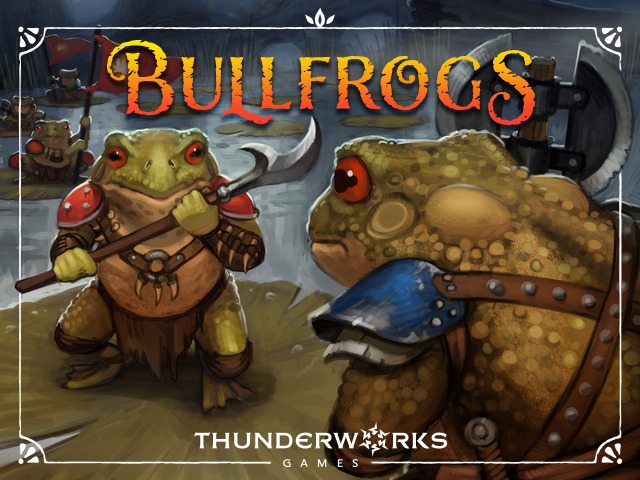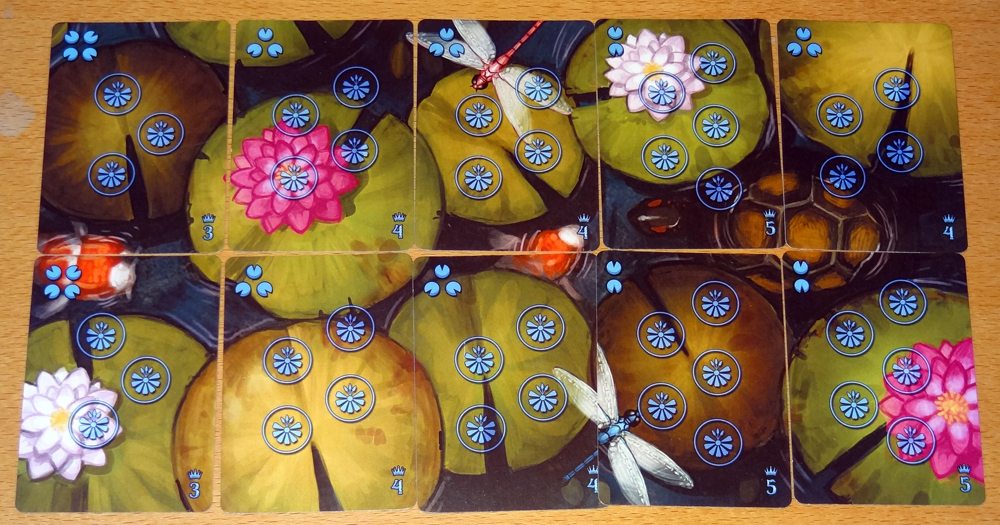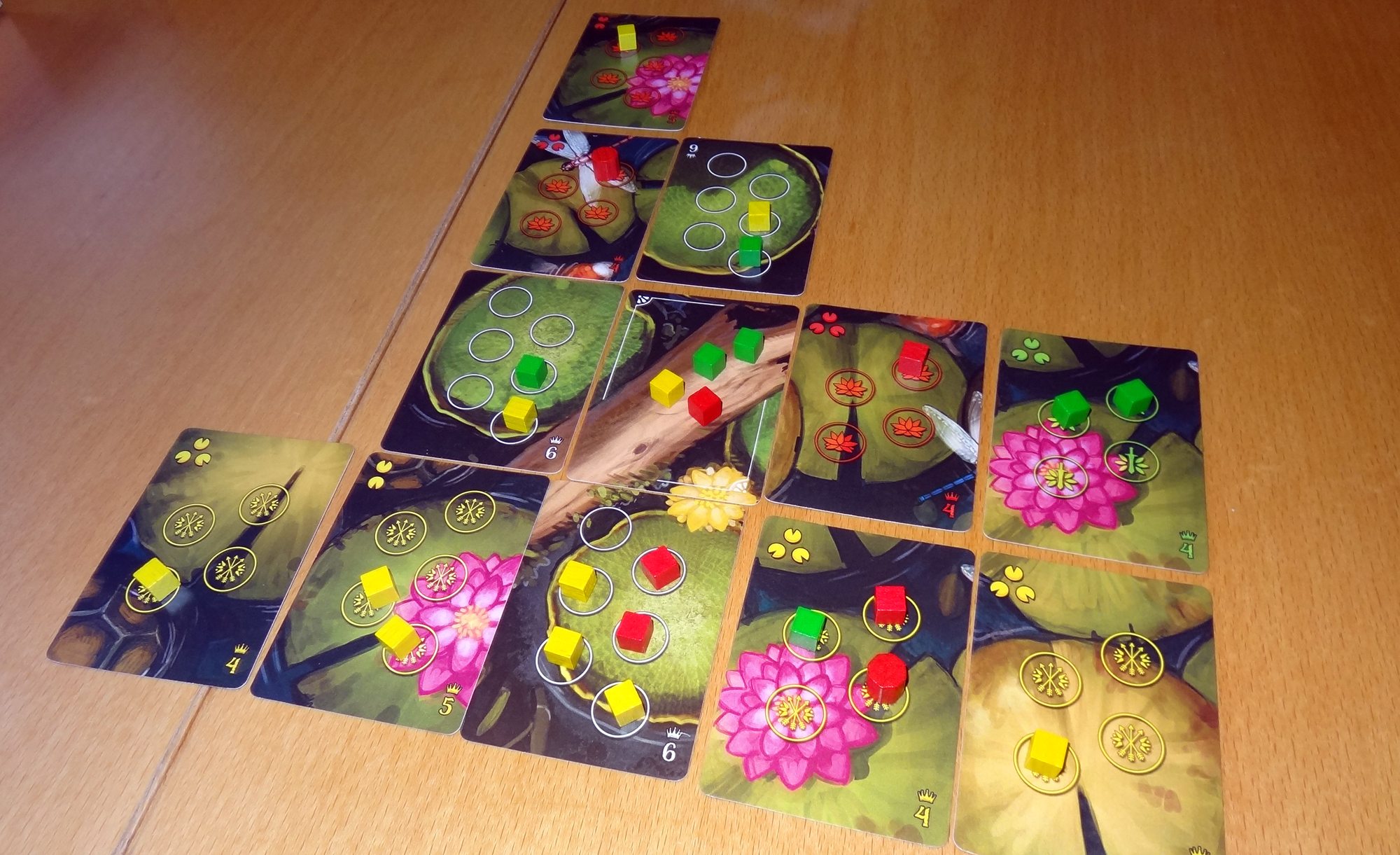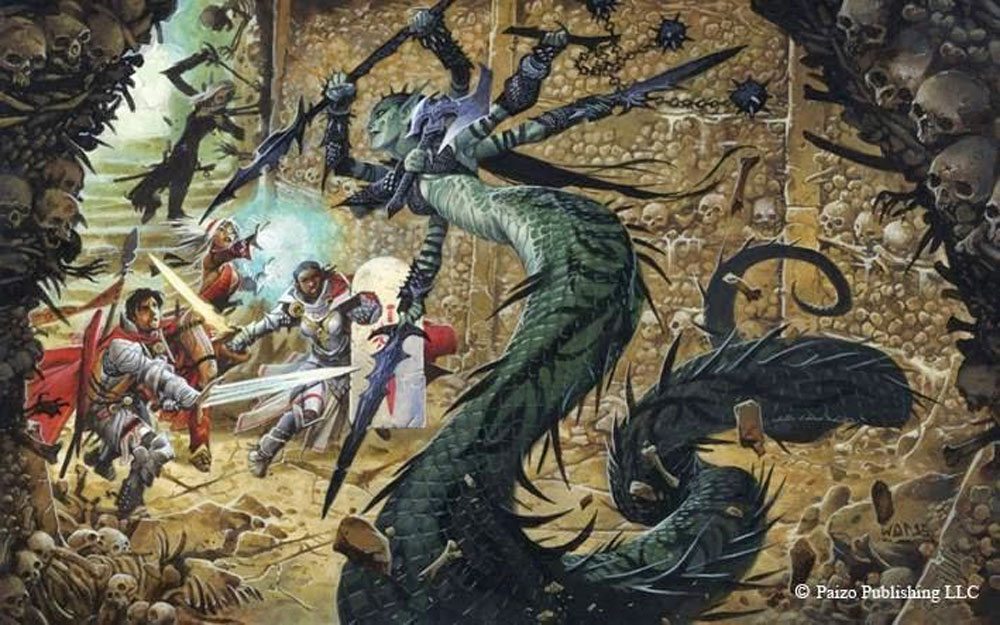 Life in the pond is tough. Every lily pad is hotly contested by factions of frog armies, who leap onto the battlefield to attack, or sabotage their enemies. This is the world of Bullfrogs, a quick-playing strategy game from Thunderworks Games, just launched on Kickstarter yesterday.
Life in the pond is tough. Every lily pad is hotly contested by factions of frog armies, who leap onto the battlefield to attack, or sabotage their enemies. This is the world of Bullfrogs, a quick-playing strategy game from Thunderworks Games, just launched on Kickstarter yesterday.
At a glance: Bullfrogs is for 2 to 4 players, ages 8 and up, and plays in about half an hour. It’s an area-control game that uses cards to make up the board, and although it’s a strategy game it’s not too difficult to learn. The pledge level for a copy of the game is $22 (for the US; international shipping is higher).

Components:
- 40 Lily Pad Cards (10 in each player color)
- 4 Player Aid Cards
- 1 Log Card
- 4 Starting Lily Pad Cards
- 56 Frog Cubes (14 in each player color)
- 8 Bullfrog Cylinders (2 in each player color)
The game is pretty compact—a deck of cards and a small batch of wooden bits. The wooden cubes and cylinders are pretty standard, not really exciting but perfectly serviceable—though if the project overfunds, there are stretch goals to replace these with laser cut frog and bullfrog meeples.
The artwork is by John Arisosa, who also illustrated Mice & Mystics, and it’s beautiful. There are slightly more cartoony battle-ready frogs on the cover, but the lily pad cards themselves are done in a totally realistic fashion without the fantasy elements, so it’s a nice balance. The game itself could appeal to a wide range of players, and I think the cover may attract both kids and adults—though abstract strategy fans should also pay attention to this one.

One fun note is that each player’s 10 cards can be pieced together to form one large illustration. There is a stretch goal to do three more large illustrations so that each player has their own set of 10 cards. (Right now, each player’s set is identical.)
The cards are nicely designed, too: The backs are not only brightly colored, making them easy to sort out at the end of the game, but each color also has its own faction symbol, which are also repeated in the spaces on the fronts of the cards. The player summary cards are also colored to match, and have two spaces on them to store the bullfrogs once they’re out of play.
The card art and design make Bullfrogs an eye-catching game without being overdone, and I love the look of it.
How to play
You can download the rules here, and even a free Print-and-Play if you want to try the game out for yourself.
The goal of the game is to score the most points in ten rounds of play by capturing lily pads and getting frogs onto the log in the center of the pond.
To set up, the five starting cards are laid out, with the log in the center. Then each player takes all the bits and cards of their color, shuffles their own cards, and draws three cards.

Each player’s turn has four steps: play a card, take actions, score, and draw a card.
1. Play a card: play a card to the table, adjacent to any of the cards already in the pond.
2. Take actions: each player card has a number of little lily pad icons in the top left corner, representing how many actions that player may take. You may deploy frogs or bullfrogs to any other lily pad card in the same row or column as the card you played (but not on the card itself), up to two per card, as long as there are empty spaces. You may also sabotage other player’s frogs in the same row or column by jumping them onto adjacent cards (including the log). However, you can’t sabotage a bullfrog, and you can’t sabotage anyone from the log card.
3. Score lily pads: If any lily pad cards are now filled, then that card will get scored and removed from the pond. The player with the most frogs wins the card and puts it in a scoring pile—bullfrogs count double. If there’s a tie, the card sinks and nobody gets it. The frogs on the card can jump to adjacent cards, one per card, if there is room, starting with the losing players’ frogs, then the losing players’ bullfrogs, then the winning player’s frogs and the winning player’s bullfrogs. Any remaining frogs are returned to their owners’ supplies, and any remaining bullfrogs are out of the game (placed on the turn summary cards).
The jumping can cause other cards to be filled, in which case they’re also scored and removed, and so on. If there are now gaps in the board, the lily pads are then moved (at the active player’s discretion) so that it’s all one contiguous board gain.
4. Draw a card from your deck.
The game continues until everyone has played all of their cards—ten full rounds.

At the end of the game, you score points for each lily pad card you captured, plus a bonus point for each card of your own color you captured. You also get 1 point per frog and 2 points per bullfrog on the log. Whoever has the most frogs on the log gets a bonus 3 points (nobody gets points if there’s a tie). Highest score wins, and ties go to the player with the most frogs left in play.
The Verdict
Bullfrogs is the first release from designer Keith Matejka and also his first Kickstarter campaign, and it’s a great debut. Certainly the finished artwork from John Arisosa helps, but the game itself is elegant and beautifully designed, too. The rules are pretty easy to learn and it’s something that I could play with my kids and my strategy-loving adult friends (though maybe not at the same time). Although it’s a pretty short game and the components (if not the box) could fit in your pocket, the depth of the gameplay make it richer than a typical “filler” game.
The player cards give you more actions if you play the cards with fewer spaces—which then gives other players easier cards to attack and score on their turns. However, getting a 5-space card out there only gives you two actions. In the end, of course, you’ll play all of your cards so everyone has the same number of actions overall, but choosing when to take fewer actions and when to take more is a deliciously tough decision.
The log card is a bit like the farms in Carcassonne—it doesn’t score until the end, and can be worth a lot of points, but committing your frogs there means they’re not available for the rest of the game. Getting onto the log is tricky, too. Since you can’t deploy directly to the log and you can’t sabotage your own frogs, you have to rely on your opponents to sabotage your frogs onto the log, or hope you can jump on there after scoring an adjacent lily pad. But even that isn’t guaranteed, because the person who wins a lily pad jumps last. You often have to strike a balance between allowing an opponent to score so that your frog survives to the next card, or getting those points to yourself at the cost of your own frogs (or bullfrogs).
One of the greatest joys of playing Bullfrogs, though, is seeing a well-planned deploy-and-sabotage move come together that allows you to chain several battles in a row. Frogs jumping from one filled card fill up a second card, which scores, and then fills up a third card … if you play it just right, you can score big on a single turn. That cascading effect reminds me a little of Tongiaki, an old favorite in which the state of the board can change dramatically in one round.
So far I haven’t seen one optimal strategy, either, as scores have been pretty close. If you manage to get a couple of the six-point starting cards, that generally gives you a good leg up, but you could also focus on getting your own color cards (lots of bonus points) or just get a bunch of frogs onto the log for a nice end-game bonus. There are different routes to victory, and probably the most important thing is to pay attention to what your opponents are doing so they don’t get too far in any particular direction.
Overall, I’m impressed and I think Bullfrogs would make an excellent addition to your game collection. It does involve a good deal of strategy, but there are only ten rounds of play so it doesn’t drag. The $22 price tag may seem slightly high based on the components alone, but I think the gameplay you’ll get out of it is worth it.
For more about Bullfrogs, check out the Thunderworks Games website, or go to the Kickstarter page to pledge for a copy!
Disclosure: GeekDad received a demo prototype of this game for review.




